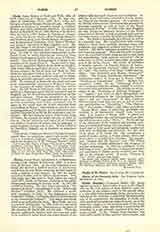

Clerks Regular.—Canonical Status.—By clerks regular are meant those bodies of men in the Church who by the very nature of their institute unite the perfection of the religious state to the priestly office, i.e. who while being essentially clerics, devoted to the exercise of the ministry in preaching, the administration of the sacraments, the education of youth, and other spiritual and corporal works of mercy, are at the same time religious in the strictest sense of the word, professing solemn vows, and living a community life according to a rule solemnly approved of by the sovereign pontiff. In the “Corpus Juris Canonici” the term clerks regular is often used for canons regular, and regular clerks are classed by authors as a branch or modern adaptation of the once world-famous family of regular canons (see Canons and Canonesses Regular). This is because of the intimate connection existing between the two; for while separated from the secular clergy by their vows and the observance of a community life and a rule, they form a distinct class in the religious state, the clerical, in opposition to the monastic, which includes monks, hermits, and friars. Clerks regular are distinguished from the purely monastic bodies, or monks, in four ways: They are primarily devoted to the sacred ministry; not so the monks, whose proper work is contemplation and the solemn celebration of the liturgy. They are obliged to cultivate the sacred sciences, which, if cultivated by the monks, are yet not imposed upon them by virtue of their state of life. Clerks regular as clerics must retain some appearance of clerical dress distinct from the habit and cowl of the monk. And lastly, because of their occupations, they are less given to the practice of austerity which is a distinct feature of the purely monastic life. They are distinguished from the friars in this, that though the latter are devoted to the sacred ministry and the cultivation of learning, they are not primarily priests. Finally, clerks regular differ from canons regular in that they do not possess cathedral or collegiate churches, devote themselves more completely to ministerial work in place of choir-service, and have fewer penitential observances of rule.
History.—The exact date at which clerks regular appeared in the Church cannot be absolutely determined. Regular clerks of some sort, i.e. priests devoted both to the exercise of the ministry and to the practice of the religious life are found in the earliest days of Christian antiquity. Many eminent theologians hold that the clerks regular were founded by Christ Himself. In this opinion the Apostles were the first regular clerks, being constituted by Christ ministers par excellence of His Church and called by Him personally to the practice of the counsels of the religious life (cf. Suarez). From the fact that St. Augustine in the fourth century established in his house a community of priests leading the religious life, for whom he drew up a rule, he has ordinarily been styled the founder of the regular clerks and canons, and upon his rule have been built the constitutions of the canons regular and an immense number of the religious communities of the Middle Ages, besides those of the clerks regular established in the sixteenth century. During the whole medieval period the clerks regular were represented by the regular canons who under the name of the Canons Regular or Black Canons of St. Augustine, the Premonstratensians or White Canons, Canons of St. Norbert, etc., shared with the monks the possession of those magnificent abbeys and monasteries all over Europe which, even though they are in ruins, compel the admiration of the beholder.
It was not until the sixteenth century that clerks regular in the modern and strictest sense of the word came into being. Just as the conditions obtaining in the thirteenth century brought about a change in the monastic ideal, so in the sixteenth the altered circumstances of the times called for a fresh development of the ever fecund religious spirit in the Church. This development, adapted to the needs of the times, was had in the various bodies of simple clerics, who, desirous of devoting themselves more perfectly to the exercise of their priestly ministry under the safeguards of the religious life, instituted the several bodies which, under the names of the various orders of regular clerics, constitute in themselves and in their imitators one of the most efficient instruments for good in the Church militant today. So successful and popular and well adapted to all modern needs were the clerks regular, that their mode of life was chosen as the pattern for all the various communities of men, whether religious or secular, living under rule, in which the Church has in recent times been so prolific. The first order of clerks regular to be founded were the Theatines (q.v.) established at Rome in 1524; then followed the Clerks Regular of the Good Jesus, founded at Ravenna in 1526, and abolished by Innocent X in 1651; the Barnabites (q.v.) or Clerks Regular of St. Paul, Milan, 1530; The Somaschi (q.v.) or Clerks Regular of St. Majolus, Somasca, 1532; the Jesuits or the Society of Jesus (q.v.), Paris, 1534; the Regular Clerks of the Mother of God, Lucca, 1583; the Regular Clerks Ministering to the Sick, Rome, 1584; the Minor Clerks Regular, Naples, 1588; and the Piarists or Regular Clerks of the Mother of God of the Pious Schools, Rome, 1597. Since the close of the sixteenth century no new orders have been added to the number, though the name Clerks Regular has been assumed occasionally by communities that are technically only religious, or pious, congregations
JOHN F. X. MURPHY

